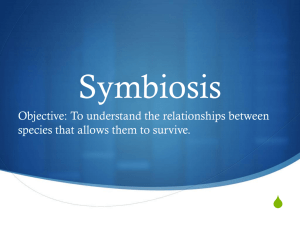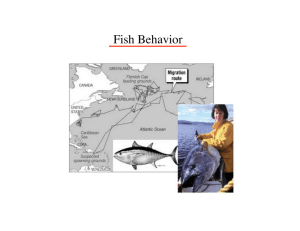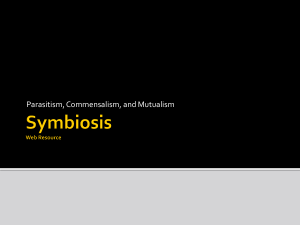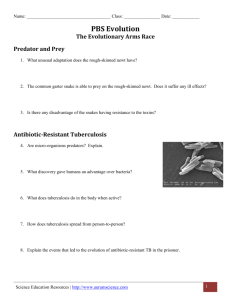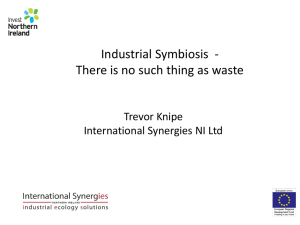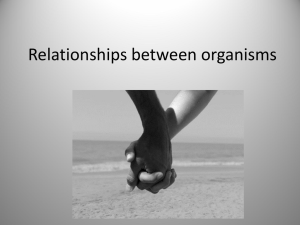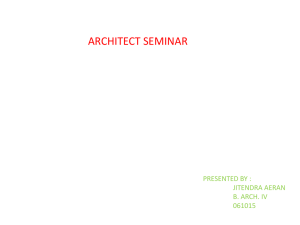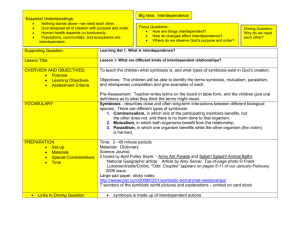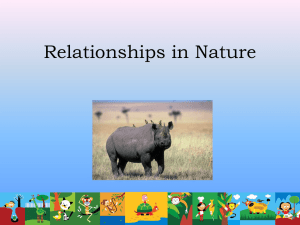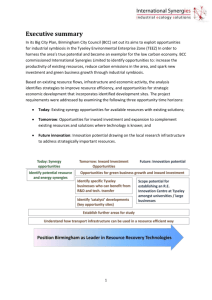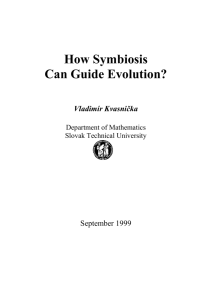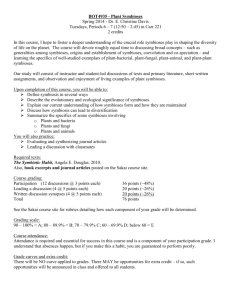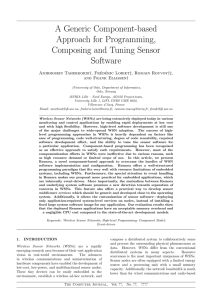Document
advertisement
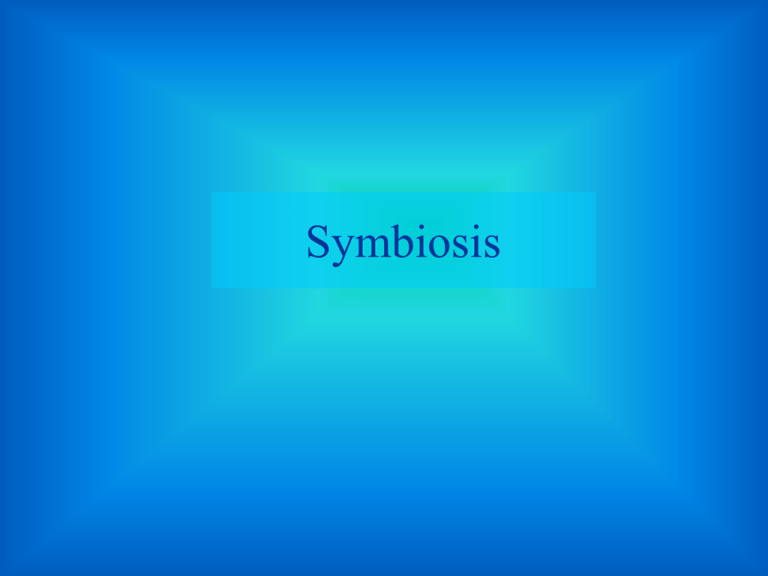
Symbiosis What is common? • In a tropical ocean,a remora fish uses a structure on top of its head to attach itself to the belly of a shark and get a free ride. • A honey guide bird in Africa leads a furry ratel to a wild beehive.With its sharp claws, the ratel rips open the hive.The ratel laps up the honey as the honey guide bird dines on bee wax. It is Symbiosis !! Types of Symbiosis Symbiosis Mutualism Commensalism Parasitism Mutualism • Advantages for both partners Cleaning Symbiosis • The drawing shows the Nile crocodile opening its mouth to permit the Egyptian plover to feed on any leeches attached to its gums. • Cleaning symbiosis is more common in fish. Another Example of Mutualism • Many of the bacteria live in our large intestine. They feed on food in the gut and do not harm us. And some probably help us by producing vitamins; that is, the relationship is mutualistic. • The goby fish and snapping shrimp live in a sandy burrow built by the shrimp. Because the shrimp is nearly blind, it keeps one of its long feelers on the goby. When danger approaches, the goby warns its partner with flicks of its fins, and both partners retreat to their burrow. Neither of them can survive on their own. Commensalism • One partner living on the other with no obvious effect on the second. Examples of Commensalism • The remora fish and the shark. The dorsal fin of the remora is modified into a sucker with which it forms a temporary attachment to the shark. When the shark feeds, the remora picks up scraps. The shark makes no attempt to prey on the remora. • Some species of barnacles are found only as commensals on the jaws of whales. And there are other species of barnacles found only as commensals on those barnacles.! More • High in the branches of a tree, fierce hawk called osprey builds a big, flat nest for its eggs. Sparrows set up their homes beneath the osprey’s nest for protection. Osprey feed on fish anyway. Parasitism • One partner living on the other with detrimental effect on the second A parasite is an organism that • Lives on or in the body of another organism (the host) • From whose tissues it gets its nourishment, and • To whom it does some damage Parasites damage their host in two major ways, by consuming its tissues, e.g., hookworms and/ or liberating toxins • Animals are parasitized by viruses, bacteria, fungi, flatworms (tapeworms and flukes), and insects (fleas, lice). • Plants are parasitized by viruses, bacteria, fungi, and a few other plants. Check your understanding What kind of symbiosis is it? The Light-Organ Symbiosis of Vibrio fischeri and the Hawaiian squid • During the day the bobtailed squid remains buried in the sand of shallow reef flats. As the sun sets, the nocturnal animal emerges from its safe hiding place and searches for food. In the moonlit night, the squid would appear as a dark silhouette when it swims through the water and would be easily detected by predator fish from below. It is thought that the squid camouflages itself by projecting light downward from its light organ. Inside the light organ are luminescent bacteria that produce the light. The Nutritional Symbiosis of Buchnera and Aphids • Aphids are plant pests, capable of causing major agricultural damage. They feed on plants by piercing them with syringe-like mouth parts and sucking the sap out of the phloem, resulting in a diet that is rich in carbohydrates and deficient in amino acids. Some of these amino acids cannot be synthesized by the insect but are supplied by symbiont. The interaction of the two partners dates back 150 to 250 million years and both have become so dependent on each other that under natural conditions they cannot exist without each other. What kind of Symbiosis? • Your relationship with your pet • The relationship of a dog and a flea • Orchids survive in dense, shadowy jungles by growing on tall trees to get plenty of sunlight and absorbing water and nutrients off the tree bark. • Humans and microscopic organisms called mites living in their eyebrows. What kind of Symbiosis? • Diseases-causing bacteria and viruses and humans • Fungi that causes athlete’s foot • Cuckoos lay their eggs in other bird’s nests. When the baby cuckoo hatches, it pushes the eggs and young of its foster parents out of the nest. Foster parents are tricked into feeding and caring for the cuckoos.
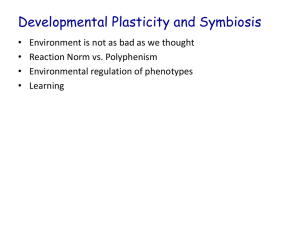
![Symbiosis[1]](http://s2.studylib.net/store/data/005449742_1-2c9de7b7b178f521480e9109673f342e-300x300.png)
